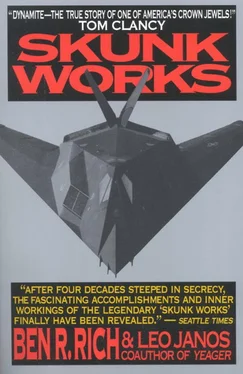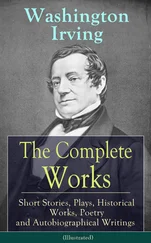In the end we had to team up with Northrop to pay for the poles, because the Air Force wasn’t about to foot the bill. It cost around half a million dollars. And I designed a double-wedge pylon which they tested on a 50,000-watt megatron, state of the art in transmitters, that could pick up an object the size of an ant from a mile away. On that radar the pole was about the size of a bumblebee. John Cashen, who was Northrop’s stealth engineer, was in the control room when they fired up the radar. And I overheard their program manager whisper to John: “Jesus, if they can do that with a frigging pole, what can they do with their damned model?”
Ben called me every day for the latest results. The model was measuring approximately the equivalent of a golf ball. One morning we counted twelve birds sitting on the model on top of the pole. Their droppings increased the radar cross section by one and a half decibels. Three decibels is the equivalent of doubling its cross section. And as the day heated on the desert, inversion layers sometimes bent the radar off the target. One day, while using supersensitive radar, the inversion layer bent the beam off the target, making us four decibels better than we deserved. I saw that error, but the technician didn’t. What the hell, it wasn’t my job to tell him he had a false pattern. I figured Northrop probably benefited from a few of them too, and it would all come out in the wash.
But then Ben Rich called me and said, “Listen, take the best pattern we’ve got, calculate the cross section level, and tell me the size of the ball bearing that matches our model.” This was a Ben Rich kind of idea. The model was now shrunk down from a golf ball to a marble because of bad data. But it was official bad data, and no one knew it was bad except little me.
So Ben went out and bought ball bearings and flew to the Pentagon and visited with the generals and rolled ball bearings across their desktops and announced, “Here’s your airplane!” Those generals’ eyes bugged out of their heads. John Chasen was livid when he found out about it because he hadn’t thought of it first. “That goddam Ben Rich,” he fumed. And a few months later, Ben had to stop rolling them across the desk of anyone who wasn’t cleared.
In early April 1976, I got the word that we had officially won the competition with Northrop and would go on to build two experimental airplanes based on our Hopeless Diamond design. The program was now designated under the code name Have Blue. We knew we could produce a model with spectacularly low radar signatures, but the big question was whether we could actually build an airplane that would enjoy the same degree of stealthiness. A real airplane was not only much larger, but also loaded with all kinds of anti-stealth features—a cockpit, engines, air scoops and exhausts, wing and tail flaps, and landing gear doors. In any airplane project the design structures people, the aerodynamics group, and the propulsion and weight specialists all argue and vie for their points of view. In this case, however, I served notice that Denys Overholser’s radar cross section group had top priority. I didn’t give a damn about the airplane’s performance characteristics because its only purpose was to demonstrate the lowest radar signature ever recorded. I joked that if we couldn’t get her airborne, maybe we could sell her as a piece of modern art sculpture.
I assigned the design project to Ed Baldwin, who was our best and most experienced structural engineer. “Baldy” had started out with Kelly designing the P-80, America’s first jet fighter, in 1945, and had designed the configuration of the U-2 spy plane. His task was to take the preliminary design concept of the Hopeless Diamond and make it practical so that it could actually fly. Dick Scherrer had done the preliminary design, laying out the basic shape, and Baldwin had to make certain that the shape’s structure was sound and practical; he would determine its radius, its thicknesses, its ability to withstand certain loads, the number of parts. “Baldy” would put the rubber on the ramp.
All of our structure and wing guys worked for him, and Baldwin enjoyed badgering aerodynamicists, especially in meetings where he could score points with his fellow designers by making aerodynamicists squirm or turn beet red in fury. One on one, Baldy was a pleasant chap—at least moderately so for a crusty Skunk Works veteran—but in meetings we were all fair game and he was a bad-tempered grizzly. Early on, for example, he got into a heated exchange with a very proper Britisher named Alan Brown, our propulsion and stealth expert, about some aspect of the structure he was designing. Baldwin turned crimson. “Goddam it, Brown,” he said, “I’ll design this friggin’ airplane and you can put on the friggin’ stealth afterwards.”
The airplane Baldy designed was a single-seat, twin-engined aircraft, 38 feet long, with a wingspan of 22 feet and a height of slightly more than seven feet. Its gross weight was 12,000 pounds. The leading edge of the delta wing was razor-sharp and swept back more than 70 degrees. To maintain low infrared signatures, the airplane could not go supersonic or have an afterburner because speed produced surface heating—acting like a spotlight for infrared detection. Nor did we want the airplane to be aurally detected from the ground. For acoustical reasons we had to make sure we had minimized engine and exhaust noise by using absorbers and shields. To keep it from being spotted in the sky, we decided to use special additives to avoid creating exhaust contrails. And to eliminate telltale electromagnetic emissions, there was no internal radar system on board.
Our airplane wasn’t totally invisible, but it held the promise of being so hard to detect that even the best Soviet defenses could not accomplish a fatal lock-on missile cycle in time to thwart its mission. If they could detect a fighter from a hundred miles out, that airplane was heading for the loss column. The long-range radar had plenty of time to hand off the incoming intruder to surface-to-air missile batteries, which, in turn, would fire the missiles and destroy it. Early-warning radar systems could certainly see us, but not in time to hand us over to missile defenses. If the first detection of our airplane was at fifteen miles from target, rather than at fifty miles, there simply would be no time to nail us before we hit the target. And because we were so difficult to detect, even at fifteen miles, radar operators would also be thwarted while trying to detect us through a confusing maze of ground clutter.
I had asked Kelly to estimate the cost of building these two experimental Have Blue airplanes. He came back with the figure of $28 million, which turned out to be almost exactly right. I asked the Air Force for $30 million, but they had only $20 million to spend in discretionary funds for secret projects by which they bypassed congressional appropriations procedures. So, in the late spring of 1976, I was forced to go begging for the missing $10 million to our CEO, Bob Haack, who was sympathetic but not particularly enthusiastic. He said, “Look, Ben, we’re in tough straits right now. I don’t think we can really afford this.” I pushed a little harder and got him to agree to let me present the proposal to the full board of directors. Bob set up the meeting, and I just laid it all out. Larry Kitchen, Lockheed’s president, and Roy Anderson, the vice chairman, spoke up enthusiastically in support. I told the board I thought we were dealing with a project that had the potential for $2 to $3 billion in future sales. I predicted we would be building stealth fighters, stealth missiles, stealth ships, the works. I was accused of hyperbole by one or two directors, but in the end I got my funding, and as time went on my sales predictions proved to be conservatively low.
Читать дальше












